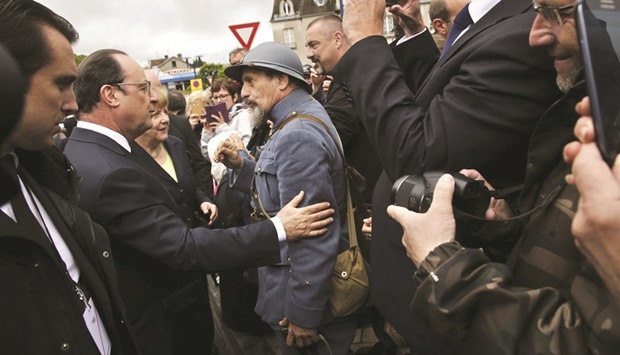Pulling and pushing each other, arms locked in mock combat, 4,000 young people from France and Germany created a tribute yesterday to the soldiers who fought at Verdun during World War I.
After running through the woods to appear on a green field, the young people – indecipherable by country and dressed in colourful T-shirts – lined up against one another and engaged in mock struggles to a fast-paced drumbeat, before freezing and collapsing when a figure symbolising death appeared.
The production was performed in front of French President Francois Hollande and German Chancellor Angela Merkel to commemorate the 100-year anniversary of the Battle of Verdun – one of the longest, and bloodiest battles of the war.
Merkel and Hollande applauded when the production ended, standing and walking onto the field where the artistic re-enactment – created by award-winning German director Volker Schloendorff – had taken place.
The leaders were in Verdun to pay tribute to the battle and send a signal of lasting German-French co-operation.
The two countries have been the driving force behind greater European integration.
“We are all called upon to keep memories alive in the future ... only those who know the past are able to take lessons from it in order to ensure a good future,” Merkel said, calling Verdun a symbol for “the unbelievable atrocity and futility of war, as well as for lessons learned and French-German reconciliation”.
The French president said that the site was at once a representation of “the worst, where Europe was lost 100 years ago, and also the best, where the city has been capable of investing in and uniting for peace and friendship between France and Germany”.
Both leaders called for European unity, warning against state-centric thinking that is a throwback to the past.
“The forces of division, separation and isolation are at work again,” Hollande warned.
Merkel said the lessons of unity should be applied to contemporary challenges like the refugee crisis.
The Battle of Verdun lasted more than nine months, pitting the German and the French against one another on a small area of northeastern France that still shows signs of the combat.
French historians say that the remains of thousands of soldiers are still scattered across the former battlefield.
The bloodbath claimed 300,000 soldiers on both sides; 400,000 others were wounded in a battle that typified trench combat in attrition warfare.
Despite the scale of destruction, the Battle of Verdun is considered by historians to have had limited strategic use, changing the front lines of combat very little.
But it has taken on symbolic value as a site of reconciliation.
In 1984, French President Francois Mitterand and German Chancellor Helmut Kohl clasped hands over graves.
Yesterday morning Hollande and Merkel visited a cemetery for German soldiers, accompanied by two children from each country as they laid a wreath under a grey sky and pouring rain.
In the afternoon, they visited the newly redesigned Verdun Memorial in the village of Fleury-devant-Douaumont.
But the main part of the ceremony was the inclusion of 4,000 young people, orchestrated in part to pass on a historical consciousness of a battle that none of the participants is alive to remember.
Schloendorff, the director, told DPA that the remembrance of Verdun was in the hands of the younger generation.
“The important thing is to take the ceremony from the politicians and the military and give it to the youth,” Schloendorff said. “It’s not about flames that will be rekindled. It’s also not about national anthems being played for the umpteenth time. It’s about the 15 minutes when the young people will fill the cemetery grounds.”

Hollande and Merkel are seen with a history re-enactor dressed as a French soldier in Verdun during ceremonies marking the 100th anniversary of the Battle of Verdun.
